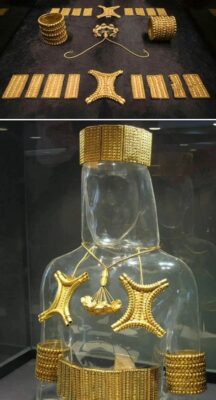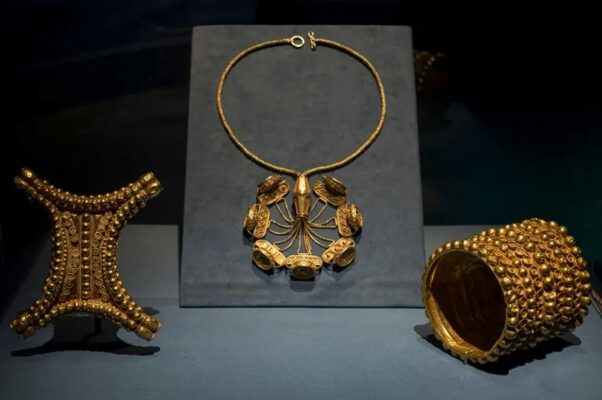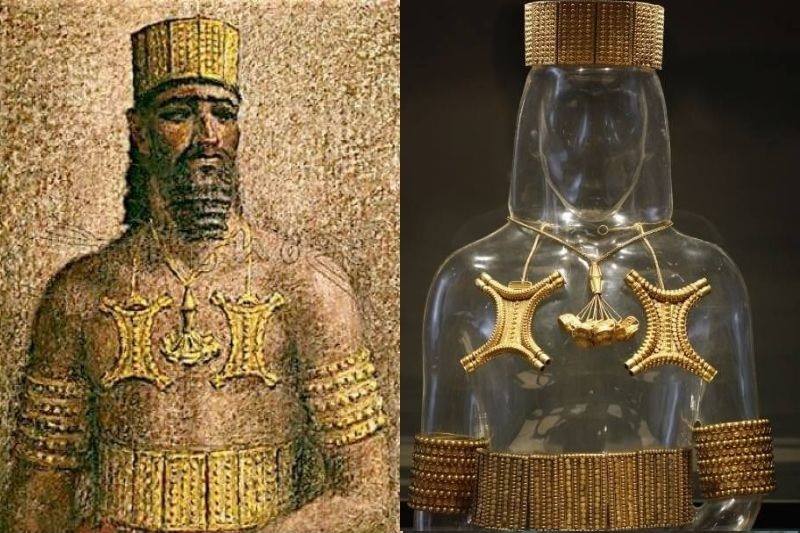The Treasure of El Carambolo is a remarkable archaeological discovery that lay hidden for millennia before its unearthing. Believed to be from the Tartessan civilization, this treasure offers a glimpse into an ancient culture rich in artistry and craftsmanship. Below, we explore its historical significance, components, and cultural implications. Follow archeology.dulichvn.net to discover many hidden mysteries that have yet to be discovered.

Origins of the Treasure of El Carambolo
1. Connection to the Tartessan Civilization
The Treasure of El Carambolo is a shining testament to the enigmatic Tartessan civilization, which flourished in the Iberian Peninsula between the 9th and 6th centuries BCE. Often referred to as one of the earliest Western European cultures, the Tartessans were known for their advanced knowledge of metallurgy, a skill they likely developed through interactions with other Mediterranean civilizations, including the Phoenicians.
This civilization’s legacy is steeped in mystery, as much of what is known comes from a combination of ancient texts and archaeological discoveries. The artifacts they left behind, including the El Carambolo treasure, reflect a highly sophisticated society with a deep appreciation for art, religion, and craftsmanship. The treasure’s intricate designs and unparalleled goldwork highlight the Tartessans’ mastery in metalworking, a skill that set them apart in the ancient world.
Some historians even speculate that Tartessus, the mythical city mentioned in Greek texts, was the heart of this civilization. The El Carambolo treasure might have belonged to an elite class or religious institution, underscoring the Tartessans’ wealth and cultural influence in their era.
2. Dating Back to the Sixth Century BCE
Experts have dated the Treasure of El Carambolo to the sixth century BCE, a time when the Tartessan civilization was at its zenith. This era marked a period of cultural and economic prosperity, fueled by active trade routes connecting Tartessan ports to Phoenician cities across the Mediterranean.
The sixth century BCE was a transformative time for the region. The Tartessans were known to assimilate foreign influences into their own culture, and their artifacts often feature motifs and techniques borrowed from the Phoenicians, including the use of gold and elaborate designs. The treasure exemplifies this synthesis, with its blend of indigenous styles and external artistic elements, reflecting a vibrant exchange of ideas and resources.
This period also saw the Tartessans exert significant influence over neighboring communities, solidifying their place as a cultural and economic powerhouse in the ancient Iberian Peninsula. The treasure, with its exquisite craftsmanship, likely served as both a symbol of power and a testament to the Tartessans’ golden age.
3. Discovery After Millennia
Hidden beneath the sands of time for over two millennia, the Treasure of El Carambolo was rediscovered in 1958 during construction work near Seville, Spain. Workers stumbled upon the treasure while digging, uncovering a collection of gold artifacts that would rewrite the narrative of ancient Iberian history.
The discovery site, located on a hill overlooking the Guadalquivir River, provided important clues about the treasure’s origins. Archaeologists believe the area may have been a ceremonial center or a sacred site for the Tartessan civilization. The treasure’s exceptional state of preservation suggests that it was deliberately buried, possibly as part of a ritual offering or to protect it during times of conflict.
This remarkable find captured global attention, with the gleaming gold artifacts offering a pristine window into a world long forgotten. The discovery not only illuminated the brilliance of Tartessan craftsmanship but also reignited interest in this mysterious civilization, sparking debates and further exploration into their history and culture.

Composition of the Treasure
1. Necklace with Pendants
Among the treasures of El Carambolo, the necklace with pendants stands out as a masterpiece of ancient craftsmanship. Composed of intricately designed gold elements, the necklace showcases the unparalleled skill of Tartessan goldsmiths. Each pendant is delicately shaped, featuring fine details that hint at both artistic intent and symbolic meaning.
The design reflects influences from the broader Mediterranean world, likely incorporating techniques and motifs shared through trade with the Phoenicians. These pendants may have held ceremonial or cultural significance, possibly symbolizing divine protection, prosperity, or social status. The necklace’s elegance and refinement underscore the Tartessan civilization’s ability to merge artistry with cultural expression, making it a key highlight of the treasure.
2. Bracelets and Pectorals
The two gold bracelets and pectorals in the collection further illustrate the Tartessans’ artistry and their cultural sophistication. The bracelets are crafted with a balance of form and function, their smooth finish and precise geometry reflecting advanced metalworking techniques. These items likely adorned the wrists of elite individuals, serving as both decorative ornaments and status symbols.
The pectorals, shaped like ox hides, are particularly intriguing. This design choice is believed to represent wealth and abundance, as ox hides were often associated with trade and economic prosperity in ancient cultures. The pectorals’ bold, symmetrical design suggests they may have been worn during significant ceremonies or rituals, marking the wearer as a person of high rank or religious authority.
3. Plaques: Diadem or Necklace?
The treasure also includes 16 gold plaques, whose original purpose has long been a topic of scholarly debate. Each plaque is meticulously crafted, featuring intricate patterns that reflect the Tartessans’ aesthetic sensibilities and technical prowess.
While their exact use remains uncertain, experts suggest that these plaques could have been components of a diadem—a crown-like ornament worn around the head—or part of an elaborate necklace. If part of a diadem, the plaques would signify regal or ceremonial authority, potentially worn by a ruler or high priest. Alternatively, as part of a necklace, they might have adorned an individual of significant social or spiritual importance.
The ambiguity surrounding the plaques adds an air of mystery to the treasure, highlighting the rich cultural and symbolic complexity of the Tartessan civilization. Regardless of their original purpose, these artifacts affirm the Tartessans’ remarkable ingenuity and their ability to create objects that blend functionality, symbolism, and beauty.

Cultural Significance of the Treasure
1. Symbol of Power and Wealth
The Treasure of El Carambolo is a striking embodiment of power and wealth, serving as a testament to the social and political structure of the Tartessan civilization. The use of gold—highly valued for its rarity, durability, and luster—underscores the treasure’s association with affluence and prestige. Its intricate craftsmanship, evident in every piece, suggests it was not merely decorative but a potent symbol of authority and influence.
Given its opulence, the treasure was likely owned by a high-ranking individual, such as a ruler, chieftain, or noble. Alternatively, it may have belonged to a religious institution, symbolizing divine favor and the sanctity of its rituals. In either case, the treasure’s presence would have served as a visual proclamation of the owner’s status, reinforcing social hierarchies and consolidating power within the Tartessan society.
2. Religious and Ritual Importance
The religious and ceremonial significance of the Treasure of El Carambolo cannot be overstated. Scholars believe that these artifacts played a central role in Tartessan spiritual practices, possibly used in rituals to honor their gods or commemorate key events. The precise symbolism of the treasure remains open to interpretation, but its ornate designs and meticulous craftsmanship suggest a deep connection to sacred traditions.
The pectorals, shaped like ox hides, and the plaques, potentially part of a diadem or necklace, may have been worn by priests or priestesses during religious ceremonies. Such objects could have served as offerings to deities, marking occasions of prosperity, successful harvests, or victories in battle. The deliberate burial of the treasure further hints at its ritualistic use, possibly as a votive offering meant to appease the gods or protect the community during times of crisis.
3. Connection to Phoenician Influence
The designs and techniques evident in the Treasure of El Carambolo strongly reflect Phoenician influence, highlighting the Tartessans’ active engagement in Mediterranean trade networks. The Phoenicians, renowned as skilled artisans and traders, frequently interacted with the Tartessans, exchanging goods, cultural ideas, and technological expertise.
This cultural exchange is particularly visible in the treasure’s ornamental motifs and advanced goldsmithing techniques, which mirror those found in Phoenician artifacts. The presence of such influences demonstrates the Tartessans’ openness to external ideas and their ability to integrate them seamlessly into their own artistic traditions.
The treasure’s Phoenician-inspired elements also underscore the interconnectedness of ancient Mediterranean civilizations, where commerce and cultural diffusion shaped societies. For the Tartessans, these influences not only enriched their artistry but also reinforced their status as a prominent player in the ancient world’s dynamic economic and cultural landscape.
See more: Chittorgarh Fort: A Timeless Symbol of Rajput Valor and Architecture
Conclusion
The Treasure of El Carambolo is more than a collection of gold artifacts; it is a window into the Tartessan civilization’s artistry, culture, and connections with the ancient world. Its discovery continues to captivate archaeologists and history enthusiasts alike, preserving the legacy of a long-lost era.
By exploring its origins, composition, and cultural significance, we uncover the timeless allure of this ancient treasure.


CÁC TIN KHÁC
Mary Walton: The Forgotten Inventor Who Helped Clean Up America’s Cities
Tomb of Queen Nefertari in the Valley of the Queens, Egypt
Discover the Hypostyle Hall of the Temple of Hathor at Dendera
Venus de Losange: Unveiling the Mystery of a 20,000-Year-Old Paleolithic Icon